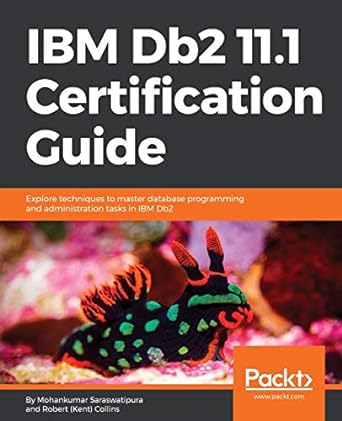Answered step by step
Verified Expert Solution
Question
1 Approved Answer
Q 1 Throughout this problem, you are a broker interfacing with the Berkeley Exchange. Your program will read events from stdin and emit output to
Q
Throughout this problem, you are a broker interfacing with the Berkeley Exchange. Your program will read events from stdin and emit output to stdout.
Part
In part you are tasked with tracking market activity on the Exchange. Your program will read printed trades as they come in and when requested, print market activity data for a particular security. More details below.
Input
the input is composed of a stream of data coming from the Berkeley Exchange, with two data types:
print a record of a trade on the exchange
volumecheck a computation request for your program
Each trade print is on a separate line. Each line contains the following spacedelimited fields:
the string "print"
timestamp int: the time at which the volumecheck command was issued, denoted as seconds since market open
security string: the name of the security for which to calculate
example input
print SILVER
print PEARL
volumecheck SILVER
print PEARL
input is guaranteed to be valid, note that
input is guaranteed to be nondecreasing ie each timestamp will be greater than or equal to the previous one.
string values are unquoted
all numerical values fit in standard bit primitive types
TASK
Your first goal is to calculate the running volume of trades on the market with perminute granularity.
Each time that a "volumecheck is received, print the volume and previous trade price of this security traded within the trailing seconds
you may use the following definitions:
if a volumecheck arrives at time T include all trades both printed before the volumecheck and with timestamp greater than T
volume is the sum of all relevant trade quantities
previous trade price is the price of the most recent print for this security
if no trades have been executed in the past minute for a particular security the volume is and the price is NA
implementations should be efficient for many volume checks,ie still efficient if Ovolume checks Otrade prints
Q TRADING FOR A CLIENT
In this next part, you are also tasked with trading orders on behalf of one client. The rules for volume checks and general guidelines remain as described in the previous problem statement. You are encouraged to use your solution to the previous part as a starting point for this task.
Orders
Orders have the following spacedelimited fields:
the string order
timestamp int: the time at which the order is issued.
security string : the name of the desired security to trade
client string: the client's name
goalshares positive integer:the number of shares the client would like to trade
participationrate decimal: A digit decimal in naming what percentage of this securitys trailingminute market trading volume this client is willing to take for this order. More specifics order "Note on participation rate"
Examples:
order GOLD BOB
Details
Your goal, whenever an order is received, is to fulfill as many shares as possible in the order, up to goalshares and constrained by participation rate. The trades you execute will be emitted as prints just like those observed in part
Operate under the following definitions:
Orders expire seconds after they are received. An order with time stamp T may only be traded in any second T T inclusive
Your client will only ever have at most one active order for a security at any time T Equivalently, if your client sends an order at a time T for security X they will not send another order for security X until time T or later.
On the BERKELEY EXCHANGE a trade may be considered filled as soon as it is printed. The trade's volume may then be immediately removed from the client's goal shares and included in the overall market volume. The timestamp for fulfilling a trade should be the same as the most recent timestamp received from the input stream.
Always trade the maximum number shares permitted by the participation rate constraint. Never break up a feasible trade into multiple smaller trades. Shares may only be traded in integer quantities and participation rate is an inclusive lessthanorequalto constraint.
the price of each new trade you execute is the previous trade price for that security
always trade as soon as possible. That is fill all feasible trades for any active orders before moving to the next input item.
for each order, output a sequence of trade prints in order to fulfill the order. as in part a trade print is formatted as follows:
print timestampsecuritynumsharesprice
Step by Step Solution
There are 3 Steps involved in it
Step: 1

Get Instant Access to Expert-Tailored Solutions
See step-by-step solutions with expert insights and AI powered tools for academic success
Step: 2

Step: 3

Ace Your Homework with AI
Get the answers you need in no time with our AI-driven, step-by-step assistance
Get Started


